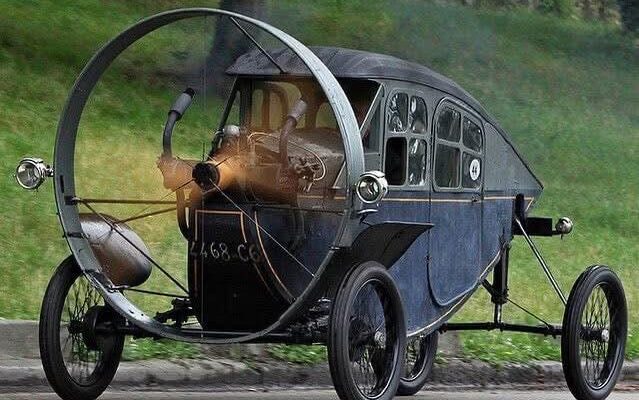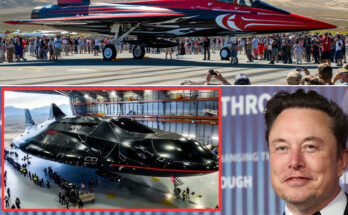In the early 20th century, a period brimming with groundbreaking innovations, Gabriel Voisin and Louis Renault were already pioneering advancements in aviation and automobiles. But among these giants of engineering emerged an audacious visionary: Marcel Leyat, a French engineer whose daring concept would redefine how people thought about cars. His creation, the Leyat Hélica, or “The Plane Without Wings,” remains one of the most peculiar yet captivating automobiles in history. A true testament to human ingenuity, the Hélica fused the worlds of aviation and automotive design, achieving both notoriety and admiration for its bold departure from convention.

A Visionary’s Dream
Marcel Leyat believed in simplicity and efficiency. In a time when heavy, cumbersome automobiles dominated the roads, he envisioned a vehicle that would embrace lightweight design and aerodynamic efficiency. Inspired by the burgeoning aviation industry, Leyat decided to craft a car that operated more like a plane—not with traditional engines and heavy gearboxes, but with propeller-driven motion. The result? A car that defied the norms of its time and became a symbol of experimental genius.
The Unorthodox Design
The Leyat Hélica’s design was nothing short of revolutionary. It resembled a carriage stripped down to its bare essentials, with a wooden frame to reduce weight and improve performance. Instead of an internal combustion engine driving the wheels, the Hélica featured a large wooden propeller mounted at the front of the car. This propeller, powered by a lightweight engine, provided thrust, much like an airplane. The design eliminated the need for a gearbox or drivetrain, simplifying the mechanics and reducing overall weight.
The result was astonishing: the Hélica weighed only 550 pounds (250 kilograms), making it far lighter than conventional cars of the era. Its minimalist construction, free from heavy steel frames and complex machinery, epitomized Leyat’s belief in engineering elegance. To enhance its aerodynamics further, the car had a long, sleek body that mirrored the fuselage of an airplane.
Performance That Stunned the World
While the Leyat Hélica looked unconventional, it delivered impressive performance for its time. The car could achieve speeds of up to 106 mph (171 km/h), a remarkable feat considering the limited technology of the 1920s. This record was set in 1927 at the Montlhéry circuit near Paris, where the Hélica demonstrated its capabilities and stunned skeptics who had doubted the practicality of a propeller-driven automobile.
What made this achievement even more remarkable was the Hélica’s efficiency. Thanks to its lightweight design, it required far less fuel than traditional cars, making it an economical choice. However, its unique propulsion system also came with its share of challenges.
Safety and Public Perception
While the Hélica’s performance was impressive, its design raised significant safety concerns. The open, spinning propeller at the front posed a serious hazard to pedestrians and other vehicles. Imagine driving through a busy street with a whirling blade leading the way—it was as dangerous as it sounds. These concerns limited the car’s appeal and practicality, particularly in urban settings where safety regulations were becoming increasingly stringent.

Public perception of the Hélica was a mix of fascination and apprehension. Many marveled at its innovative design and performance, but others viewed it as an impractical and risky experiment. Despite these mixed reactions, Leyat remained undeterred in his pursuit of innovation.
Limited Production but Lasting Impact
Between 1919 and 1925, Marcel Leyat managed to produce and sell 30 units of the Hélica. While this number pales in comparison to the mass production figures of contemporaries like Ford, it is a testament to the niche appeal of Leyat’s creation. Each Hélica was hand-built, with customization options for buyers who were willing to embrace its unconventional design.
Leyat marketed the Hélica as the “car of the future,” emphasizing its lightweight construction, fuel efficiency, and aerodynamic design. Though it never achieved mainstream success, the Hélica found a dedicated following among those who appreciated its avant-garde engineering and bold aesthetic.
Challenges and Legacy

The Leyat Hélica faced numerous challenges that ultimately limited its success. Beyond safety concerns, the car’s reliance on propeller-driven motion made it difficult to control, particularly in strong winds. Its unique design also made it a curiosity rather than a practical mode of transportation, and it struggled to compete with more traditional automobiles that were becoming increasingly reliable and affordable.
Despite these challenges, the Hélica’s legacy endures. It serves as a reminder of the importance of thinking outside the box and pushing the boundaries of conventional design. Marcel Leyat’s innovative spirit paved the way for future engineers and designers to explore new possibilities in transportation.
A Symbol of Experimental Brilliance

Shift Your Knowledge into High Gear
Whether you’re a gearhead or just love cars, our newsletter has you covered. Stay up-to-date on the latest models, trends, and technologies with our regular updates.
Today, the Leyat Hélica is celebrated as a symbol of early automotive experimentation. Only a few examples of the car remain, preserved in museums and private collections as artifacts of a bygone era. They stand as a testament to Marcel Leyat’s ingenuity and his willingness to challenge the status quo.
In a world where innovation often involves incremental improvements, the Hélica reminds us of the value of radical thinking. It encourages us to question assumptions and explore unconventional solutions, even if they seem impractical or risky at first glance.
Lessons from the Leyat Hélica
The story of the Leyat Hélica offers several valuable lessons for innovators and entrepreneurs:
- Embrace Bold Ideas: Marcel Leyat’s decision to create a propeller-driven car was a bold move that defied conventional wisdom. His willingness to experiment with unconventional designs highlights the importance of taking risks in the pursuit of innovation.
- Simplicity Matters: By eliminating the complexities of traditional automobiles, Leyat demonstrated the power of simplicity in design. The Hélica’s lightweight construction and efficient propulsion system showcased the benefits of streamlined engineering.
- Learn from Failure: While the Hélica did not achieve commercial success, it left a lasting impact on the automotive industry. Leyat’s willingness to learn from challenges and adapt his designs is a valuable lesson for anyone seeking to innovate.
- Challenge the Status Quo: The Hélica’s unconventional design challenged traditional notions of what a car could be. It serves as a reminder that true innovation often requires challenging established norms and exploring new possibilities.
Why the Leyat Hélica Was failed ?
While the Leyat Hélica showcased extraordinary innovation, it also revealed the pitfalls of prioritizing bold ideas over practicality. The car’s reliance on a front-mounted propeller created significant hazards, not only for pedestrians but also for the driver and passengers. The spinning propeller, exposed to the environment, made the vehicle highly unsafe in urban areas, where accidents could easily occur. Additionally, the design’s dependency on aerodynamic principles rendered the car almost unusable in strong winds, where it could become unstable or uncontrollable. Its minimal protection from the elements and lack of traditional safety features meant it was far from suitable for everyday use. These flaws underscored the challenges of translating experimental concepts into real-world solutions.
Despite these challenges, the Hélica’s legacy endures. It serves as a reminder of the importance of thinking outside the box and pushing the boundaries of conventional design. Marcel Leyat’s innovative spirit paved the way for future engineers and designers to explore new possibilities in transportation.
Conclusion: A Legacy of Innovation
The Leyat Hélica may not have revolutionized the automotive industry, but its impact on the world of engineering and design is undeniable. Marcel Leyat’s creation remains a symbol of audacity, creativity, and the relentless pursuit of innovation. It inspires us to dream big, think differently, and embrace the challenges that come with pushing the boundaries of what is possible.
As we look back on the history of transportation, the Leyat Hélica stands out as a shining example of human ingenuity. It reminds us that every great achievement begins with a bold idea, and that the pursuit of innovation is a journey worth taking—even if the road ahead is uncharted.
-

Witnessing Gravity: Bringing the Cavendish Experiment to Life
-

1950 Lido and Cosmopolitan Capri: Lincoln’s Special Sporty Offerings
-

Dafaqu Bridge: A Marvel of Engineering in Guizhou, China






